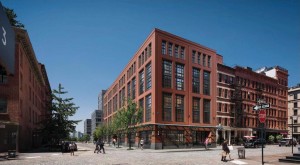
Architect’s rendering of 456 Greenwich Street. Image credit: Stephen B. Jacobs Group, P.C.
Six-story-plus-penthouse hotel approved after applicants changed the brick used in the cladding, and added masonry to large window openings. On September 8, 2015, the Landmarks Preservation Commission approved a proposal demolishing an existing building at 456 Greenwich Street in Manhattan, and constructing a new hotel, with ground-floor retail uses. The lot to be developed lies partially within the Tribeca North Historic District, with the western portion of the site lying outside of the landmarked boundaries. The site is currently occupied by a garage, originally constructed as a freight terminal building in 1942, and heavily altered in subsequent years.
The new hotel was initially presented to Landmarks, on August 3, by architect Stephen Jacobs, of the Stephen B. Jacobs Group. The hotel would rise to six stories at the street wall, with an addition set-back penthouse story, which would be minimally visible from street vantages. Zinc-clad bulkheads and mechanical equipment would be sited on the portion of the roof lying outside of the historic district. Large double-height glazed openings extending over second and third, and fourth and fifth, stories would be located on all three facade facing Greenwich, Desbrosses and Washington Streets. The opening would be divided into multiple smaller windows by aluminum girders replicating industrial steel I-beams. The penthouse story above the sixth floor would have a pool set into it, and be minimally visible from street vantages.
Commissioners did not object to the garage’s demolition, and found the proposal generally appropriate, but requested some further refinements before holding a vote. Several commissioners found the size and scale of the glass openings unsuitable for the historic district. Commissioner Michael Devonshire questioned the choice of sand-struck brick for the hotel’s cladding, and other commissioners concurred with his assessment.
In the revised plan presented at the September meeting, masonry piers would be added to double-height windows, reducing the expanse of glazing and giving the openings more district-sympathetic rectangular proportions. The hotel’s cladding would be changed to a monochromatic brick typical of the district, rather than the distinct brick originally proposed.
Commissioner Fred Bland said the revisions addressed every concern that he had had about the earlier presentation, and wholeheartedly endorsed the “great building.” Landmarks’ Chair Meenakshi Srinivasan found the revised proposal to have a more consistent window rhythm, and to have successfully addressed the commission’s concerns, and led a unanimous vote for approval.
LPC: 456 Greenwich Street, Manhattan (17-2567) (Sept. 8, 2015) (Architects: Stephen B. Jacobs Group).
By: Jesse Denno (Jesse is a full-time staff writer at the Center for NYC Law)


Although many investors indeed have earned huge amounts of
profits by flipping houses, it is important to note that this practice is
not as simple as they tell it on TV. However, due to inflation you essentially would have made nothing.
The issue comes in that most agents have buyers that are investors who purchase the properties and then place them back on the market for sale
with the same agent who had the foreclosure listed
in the first place.